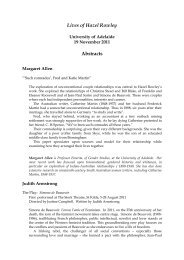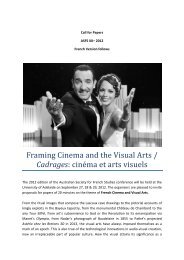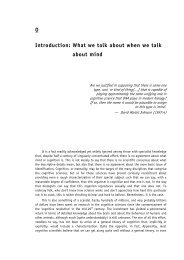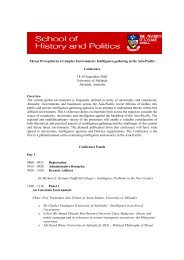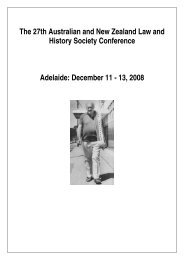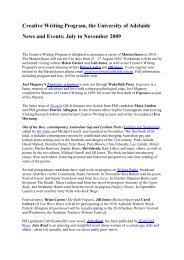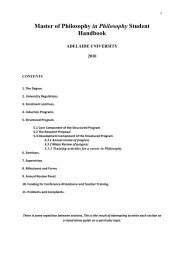Biohumanities - Paul Griffiths - Representing Genes
Biohumanities - Paul Griffiths - Representing Genes
Biohumanities - Paul Griffiths - Representing Genes
Create successful ePaper yourself
Turn your PDF publications into a flip-book with our unique Google optimized e-Paper software.
March 2008 “SCI-PHI” SYMPOSIUM<br />
43<br />
1995). This is not to suggest that the currently<br />
dominant intellectual framework<br />
does not accommodate the data that has<br />
been gathered, or even that it was not (or<br />
is not) a fruitful source of discoveries. The<br />
point is rather that there are other ways to<br />
look at that data and that there are other<br />
kinds of data that might be gathered.<br />
Philosophers of science have been less<br />
concerned than historians with the contestability<br />
of science. Their main contribution<br />
to science criticism has been to analyze<br />
the chains of reasoning that connect<br />
specific scientific findings to claims about<br />
the broad significance of those findings.<br />
There is a very direct connection between<br />
this work and the public understanding of<br />
science, since it is just these broader claims<br />
about the wider significance of some class<br />
of scientific findings that tend to be the<br />
focus of popular science writing. For example,<br />
following the popularization of post-<br />
Hamiltonian evolutionary genetics by The<br />
Selfish Gene (Dawkins 1976) and similar<br />
works, philosophers of science discussed<br />
whether the developments in evolutionary<br />
genetics in the 1960s and 1970s really implied<br />
that the individual gene is the unit of<br />
evolutionary change. Some argued that<br />
this model of the evolutionary process was<br />
simply equivalent to more traditional models.<br />
Others argued that there were substantial<br />
scientific reasons to prefer more traditional<br />
models in at least some cases. Rather<br />
than being straightforward empirical matters,<br />
these questions were shown to turn<br />
on philosophical issues such as the nature<br />
of theory reduction or the relationship<br />
between prediction and explanation<br />
(Sterelny and <strong>Griffiths</strong> 1999). The work of<br />
a number of philosophers and biologists<br />
gradually established that the most socially<br />
prominent claim made on the basis of mid-<br />
20th-century genetics—that the fundamental<br />
principle of evolution is selfishness—is<br />
at least as much a matter of semantics as of<br />
scientific discovery (Sober and Wilson<br />
1998). Given the long history of attempts<br />
to draw lessons for society from the nature<br />
of the evolutionary process, this conclusion<br />
is of obvious value.<br />
The other way in which the biohumanities<br />
can contribute to critical science communication<br />
is through creating and criticizing<br />
broad visions of biology in the sense described<br />
in Section 2. For example, take the<br />
claim by ethologists such as Patrick Bateson<br />
(1976) and Richard Dawkins (1986) that biological<br />
development is more like the execution<br />
of a recipe than the execution of a<br />
blueprint. Communication theorists have<br />
criticized this proposal on the grounds that<br />
many audiences do not understand these<br />
metaphors in the way their creators intended<br />
(Condit 1999a, 1999b). But this assumes that<br />
Bateson and Dawkins’s aim was to find a<br />
good metaphor to communicate the known<br />
content of science. Instead, at the level of<br />
this broad summary of what we have learned<br />
from a century of genetics, the content of<br />
science is contested. The two metaphors embody<br />
different, competing visions of that<br />
content. The recipe metaphor is an attempt<br />
to communicate the vision that morphogenesis<br />
is less like the workings of a computer<br />
than a chemical reaction. Developmental biologist<br />
H Frederick Nijhout writes, “The simplest<br />
and also the only strictly correct view of<br />
the function of genes is that they supply cells,<br />
and ultimately organisms, with chemical materials,”<br />
(1990:444). Although Nijhout does<br />
not use the “r-word,” it is on the tip of his<br />
tongue: the protein-coding sequences in the<br />
genome are a list of ingredients. Thus, at the<br />
deepest level, the recipe metaphor was intended,<br />
not as a device for popularization,<br />
but as a vision of developmental biology, and<br />
one intended to be taken as seriously as 17thcentury<br />
life scientists such as Stephen Hales<br />
took the idea that the body is a machine.<br />
Critics of the blueprint metaphor have written<br />
of the need for a “gestalt-switch”—a<br />
change in scientific vision—so that, without<br />
necessarily questioning any specific findings<br />
of past research, biologists will come to see<br />
those findings differently and perhaps prioritize<br />
different questions for future research.<br />
In the same way, those who defend metaphors<br />
like that of the genetic program are<br />
usually convinced that the analogy between<br />
the genome and some aspect of computer<br />
technology is very close indeed. For example,<br />
someone who believes that small RNAs<br />
are the real key to the control of develop-






